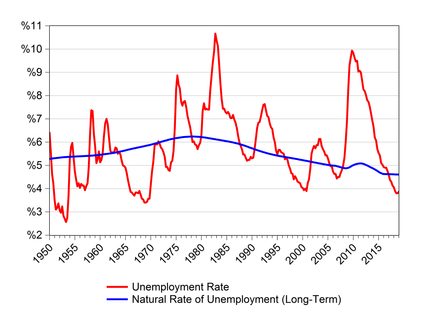Unemployment Calculator (Unemployment Rate)
This unemployment calculator is a simple tool that helps you measure the unemployment rate as a percentage for a given country. You can quickly find out how to calculate the unemployment rate. If you read further, however, you can gain some insight into what factors influence the labor market and how the US unemployment rate formula and other connected indicators are designed. Besides, you can learn some practical information, such as the current unemployment rate for the US and the natural unemployment rate.
If you are interested in other employment-related calculators, you may check some of the following tools:
What is the unemployment rate definition?
Occupation and career are essential aspects of our life: typically, we begin to prepare for a vocation from childhood, and, from that point on, we spend most of our life working until we retire. Most people rely on the financial compensation salary of their labor activity to keep their standard of living, and many people find personal accomplishment in their occupation. For these reasons, it is apparent that the loss of a job and the ensuing state of unemployment can adversely impact a person's or a family's life. It can lower the quality of life, weaken self-esteem, and, combined with uncertainty about the future, can make daily life worrisome.
Looking from a broader perspective, unemployment can harm the economy as a whole. As more people are faced with involuntary time off, the amount of goods and services delivered will also be reduced. This, in turn, will reduce the income generated in an economy. Consumption expenditure and investment (the two main components of the Gross Domestic Product) will then fall, which can hamper economic growth covered in our GDP growth rate calculator.
It is not surprising that unemployment is a leading concern in politics and economics. It is typically measured by the unemployment rate which is the fraction of the labor force that is away from work. Macroeconomists study how this variable changes, the leading factors behind it, and how it interacts with other variables.
How to calculate the unemployment rate?
Before we outline the unemployment rate formula, we shall provide some insight into its components. As usual, the initial and crucial step in forming economic indicators is obtaining the necessary inputs. Data collection related to the U.S. labor market is managed by the Bureau of Labor Statistics (BLS) through the , which involves about 60 thousand households. Based on this survey, the BLS categorizes the participants into three different groups, which are the main pillars of the final indicators:
-
Employed: This category covers paid employees, entrepreneurs, and unpaid workers in a family business.
-
Unemployed: It includes those who are not employed but are available for work and had tried to find a job during the previous four weeks.
-
Not in the labor force: This category consists of those who can not be classified into the first two categories, for example, full-time students, homemakers, or retirees.
From this information, the BLS defines the labor force as the sum of the employed and unemployed populations.
Labor force = (People employed + People unemployed) × 100
Afterward, as you probably already surmised, the unemployment rate is calculated simply as dividing the number of people unemployed by the labor force. Thus the unemployment rate formula is the following:
Unemployment rate = (People unemployed / Labor force) × 100.
Besides, BLS also computes the labor force participation rate, which is the fraction of the population that has chosen to participate in the labor market.
Labor force participation rate = (Labor force / Adult population) × 100.
You can calculate this ratio by clicking on “Labor force participation”, at the bottom part of our unemployment calculator.
The natural rate of unemployment
Economists are also interested in the normal level of unemployment rate associated with the long-term equilibrium of the labor market. It is called the natural rate of unemployment, which is the difference between the number of people who would like to have a job of a certain wage and those who are willing and able to get a job. Therefore it consists of the following:
- Frictional unemployment, which corresponds to those workers who are searching for new employment or are transitioning from one position to another, and
- Structural unemployment which arises from the fact that a certain number of jobs available in some labor markets are insufficient to provide a job for everyone who wants one.
In general, the actual unemployment rate fluctuates around the natural rate of unemployment. The deviation between the two rates is cyclical unemployment and is related to the short-term ups and downs of economic activity. Most economists believe that there is a short-run relation between the unemployment rate and the inflation rate. One explanation is that when the actual unemployment rate is under its natural level due to the tight labor market, wages tend to rise, which generates a higher price level.
The graph below depicts the historical level of the US unemployment rate together with the long-term natural rate of unemployment.

As you can see, the unemployment rate tends to vary over time as economic activity swings up and down. Although after 2008, as a result of the Global Financial Crisis, the national unemployment rate rose to a 10 percent level. By 2018, the unemployment rate had dropped below its natural level.
The above short overview shows that by providing and analyzing labor market indicators, economists and policymakers can monitor economic changes over time, allowing them to conduct analysis and form good policy recommendations.
References
- Mankiw, G. - Macroeconomics (8th edition) - 2012 - Worth Publishers; and
- U.S. Bureau of Labor Statistics.